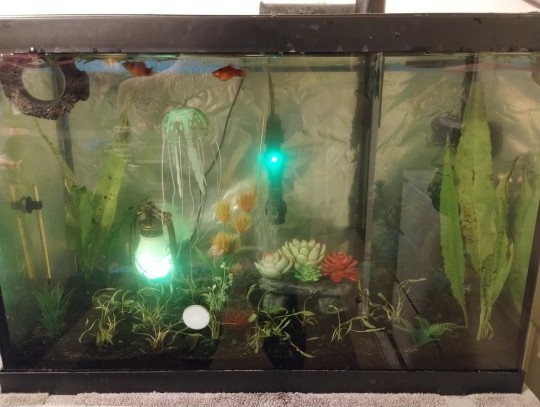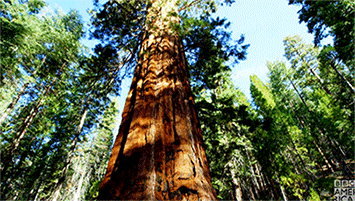#bc fake plants just gather waste and need to be cleaned.
Explore tagged Tumblr posts
Text
mom: you really spent 30 dollars on aquarium plants?
me: YES

(sorry about the horrible lighting do you have any idea how hard it is to take pictures of aquariums when the lights are off for the evening.)
#THAT'S A LOT OF PLANT FOR 30 DOLLARS OK.#IVE SEEN VENUS FLYTRAP VARIANTS MORE EXPENSIVE THAN 30 DOLLARS...#which. tempting#maybe after we move again.#sorry about the platy shit on the sand#since i last siphoned this monday and im off next monday that's my next day for Fish Shit Cleaning Palooza#and i was careful not to bury the rhizomes#some of the roots were tangled that's always a pain to deal with.#ive dealt with this shit while separating flytrap rhizomes it's not fun. it's anxiety inducing#im hoping to just replace fake plants with live plants altogether#bc fake plants just gather waste and need to be cleaned.#way more maintenance imo than a live plant#i really want pennywort though id love a good floating plant...#i read bettas love floating plants bc it mimics their natural habitat#also these plants are guaranteed snail free so yes 30 dollars is worth it lmao.#autistically infodumps in tags#hades.txt
3 notes
·
View notes
Text
Climate Change - My Facts

Humanity, for the past few decades, has been frivolous with natural resources and thus has caused unmeasurable harm to the environment. This includes: the freshwater supply, ocean wildlife, our coastal cities, and the islands. These issues are many, the odds are stacked up against the common people, and many are silenced on this issue from those with the desire to see that things remain as they are. Broken, and slowly dying. This is a conversation, the start of one with the goal of opening minds and finding a solution to all these problems.
Canada possess access to 7% of the world’s renewable freshwater supply. However, with the change in global temperatures, this fact is on course to be changed. The municipal underground sewage systems may become overflowed during any extreme rainfall event. The ensuing gushing of untreated water could push into public drinking water supplies. The loss of our mountain snow peaks, along with the earlier spring snowmelt is spurred by higher temperatures that reduce the availability of drinking water downstream. Finally, the rising of sea levels caused by the rising temperatures can lead to the salt water taking over our groundwater, especially in low-lying, gently sloping coastal areas. These changes that come with climate change will have devastating costs upon the environment.
One such pollutant of the water supply is industrial fracking. For the fracking industry, this process is a crucial tool they use to break the shale to allow the oil and gas to flow in order to harvest it. This tool is the 'fracking fluid,’ this fluid is mostly made up of freshwater and non-ionic surfactants. However, it is hard to pin down just what is in the fluid exactly. Each fracking well has their own personal recipe, and they are each very complex. There are, however, many compounds used are identified volatile organic compounds such as: benzene, toluene, ethylbenzene, and xylene. Depending on the level of exposure, with the fluid leaking out into other freshwater sources, 'fracking fluid' poses a severe health risk to those living nearby or to those who unknowingly drink water contaminated by these wells. Studies show that the use of freshwater in the fracking industry has jumped from 14% to 770% as of 2018. On average, the fluid used in the fracking process consists of 8 million litres of water, which amounts to the usage of about 65 million people’s daily consumption of freshwater.
When a well becomes depleted of its natural resources, the oil and gas industry has nowhere to put this contaminated fluid once it has been used. All the chemicals in it, as well as gas and oil, now cannot be cleaned of the pollutants. So, the industry decided that refilling these wells with the contaminated fracking fluid was a proper solution. The fluid becomes a significant risk in the environment, escaping the well and contaminating water sources nearby. One of the most glaring faults with fracking fluid wells is that: once freshwater is turned into this fluid; the contamination is so harmful that the water cannot be purified in treatment plants.
The oil and gas industry calculate that the chemicals within their fracking fluid are only 1% of the injected substance. This 1% of chemicals at first sounds like a small amount until one takes into consideration the amount of water that is used within the fracking operation. 1% of 5 million gallons, which is the approximate amount of total fluid injected, indicates that 50,000 gallons of substances in the fracking fluid were used for a single fracking job. This is all being put back into the drinking supply of neighbouring towns and public water sources.
Currently, there is hardly any public data on the effects this water can have in the surrounding ecosystems, or the overall harm it will cause to the health of those that live around these fracking sites. These sites could also, in turn, trigger earthquakes. An example of one such incident in British Columbia occurred in 2014 with a resulting 4.6 Richter scale earthquake. As well as the disrespect the fracking industry shows for natural and public resources, they have also built as many as 92 unauthorized dams to impound water for their own personal industrial use. The BC Oil and Gas Commission did not regulate the activity of these dams until they were reported on their activities.
This all, in turn, will eventually move to affect freshwater supplies and further affect our oceans. The sea, a place featured in many stories as a place of life and rebirth, is a force to be respected. For generations, cultures around the world saw the sea as an endless supply of food, transport, and a dumping ground. For in its vast size, what could civilization, or humanity, do to something so large and mighty? It turns out, however, that humanity can do a lot of damage to the oceans, and we are losing much of what makes it wonderful and so full of life.
When it comes to what floats in the sea, many first think of fish glimmering in colourful schools, others think of the largest animal on earth, the blue whale. Few people think of what really floats in the ocean waves, an island of plastic three times the size of France. The island of plastic is called, the Great Pacific Garbage Patch, and it contains at least 79,000 tons of trash. This is hardly scratching the surface of all the garbage in the ocean.
Plastic waste decomposes very slowly and is often mistaken for food by marine life. Whales, dolphins, seals, puffins, and turtles have all been found with trash blocking their stomachs and air pathways. All the garbage in the sea can also come back to the shore, where it contaminates our coastlines and other seaside habitats. It has been found that the creation of plastics will comprise 15% of our greenhouse gas emissions by 2050. In comparison, all the worlds transportation now accounts for 15% total emissions.
However, there are people trying to do something about this issue. Organizations and crews like; 4Ocean, The Ocean Cleanup, and Clean Oceans International are all part of this initiative. All these people work very hard to clean up the oceans, and each has their own meatheads. 4Ocean takes local fishing men and women, and goes out into the sea to clean up the plastic debris, they create bracelets out of these plastics for charities that the public can buy in order to show their support. Each month moves to a different charity that has something to do with the sea or its wildlife, one month it would go to sustainable fishing, another would go to marine nurseries, and so on. Each bracelet bought equals to one pound of trash taken out from the ocean. The Ocean Cleanup has come up with a technology-driven method to clean up the sea. Their system involves the creation of a fake coastline, allowing the plastic to harmlessly gather inside its U-shaped trap as well as letting fish harmlessly swim under it. A garbage boat then comes around when scanners show that the drifting system is full, it then collects the trash and takes it to shore where it is sorted and recycled. Finally, Clean Oceans International surveys the beaches and coasts to pick up plastics that float too close. Their latest expedition had them in Brazil at Itaipu Beach, where they pulled out 400 kg of plastic debris.
All these methods are wonderful efforts in cleaning up the sea, but if humanity does not help and pitch in then we say goodbye to our coral reefs, whales, polar bears, puffins, and many more. Temperatures will continue to rise, single-use plastics will be made and thrown away, the fracking industry will keep using our freshwater to generate more money. The real solution to the problem of global warming is to nip the problem before it can grow to harm us further. To talk about the health risks of fracking, to explain how trash makes its way into our oceans, to start a conversation with those that create water bottles, straws, and plastic bags into investing into safer and eco-friendly ways to live. The planet is changing, to the point where it will become unlivable for humanity. Florida will become an island or sunken city, the coasts of Hudson Bay will rise into Ontario, and places like Venice, Hawaii and Madagascar will be the new Atlantis. Banks now offer ‘Green Bonds,’ which allow investors to link their money into environmental causes. They are similar to regular bonds, but they fund projects that mitigate climate change. Cities are already acting around the world, many mayors don’t have to wait for national laws or new climate change agreements to act. They can take action today, and slowly they are. Smart Streets, Green buildings, and sustainable water management is all a reality for today's world. Generating the growth of plankton, restoring forests and sea grasslands. Planet Earth needs to be green for us to survive the growing changes. The only way to do that is for those with the power to do something, get up and use that power.

Cited Pages
“What Is Fracking Fluid?” FracTracker Alliance, www.fractracker.org/resources/oil-and-gas-101/fracking-fluid/.
Nikiforuk, Andrew. “Mega-Fracking Brings Big Jump in Industry Water Use.” The Tyee, The Tyee, 30 Aug. 2018, thetyee.ca/News/2018/08/30/Mega-Fracking-Industry-Water-Use/.
“Figure 2f from: Irimia R, Gottschling M (2016) Taxonomic Revision of Rochefortia Sw. (Ehretiaceae, Boraginales). Biodiversity Data Journal 4: e7720. Https://Doi.org/10.3897/BDJ.4.e7720.” doi:10.3897/bdj.4.e7720.figure2f.
“Global Warming Effects on the Water Supply.” Climate Hot Map, www.climatehotmap.org/global-warming-effects/water-supply.html.
The Tyee. (2019). Unregulated Energy Industry Dams At Risk, Oil and Gas Commission Finds | The Tyee. [online] Available at: https://thetyee.ca/News/2017/10/16/Unregulated-Dams-At-Risk/ [Accessed 17 Apr. 2019].
ABC News, ABC News Network, abcnews.go.com/International/great-pacific-garbage-patch-massive-floating-island-plastic/story?id=53962147.
4ocean. “4ocean Is Actively Cleaning Our Oceans and Coastlines.” 4ocean, 4ocean.com/.
Safina, Carl. “A Dead Whale Containing 90 Pounds of Plastic Is a Message in a Bottle.” CNN, Cable News Network, 21 Mar. 2019, www.cnn.com/2019/03/20/opinions/dead-whale-with-plastic-in-body-safina/index.html.
Ocean Cleanup. “The Ocean Cleanup Technology.” The Ocean Cleanup, www.theoceancleanup.com/technology/.
Coi. “Donate.” Clean Oceans International, 1 May 2018, cleanoceansinternational.org/brazil-2018/.
“Marine Problems: Climate Change.” WWF, wwf.panda.org/our_work/oceans/problems/climate_change/.
“Marine Problems: Pollution.” WWF, wwf.panda.org/our_work/oceans/problems/pollution/.
“Analysis.” Industrial Water Use, 27 Nov. 2015, www150.statcan.gc.ca/n1/pub/16-401-x/2012001/part-partie1-eng.htm.
“Environment and Climate Change Canada – Plastics Challenge – Food Packaging.” Carleton Office for Research Initiatives and Services Environment and Climate Change Canada Plastics Challenge Food Packaging Comments, 5 Nov. 2018, carleton.ca/coris/2018/environment-climate-change-food-packaging/.
#opinion#Climate Change#My Thoughts#4ocean#The Ocean Cleanup#Marine Problems#Industrial Water#Fracking#The Point is to Talk#Lets Talk#Garbage Islands#environmetalists#global warming#canadian thoughts#Plastics#single use plastic
0 notes